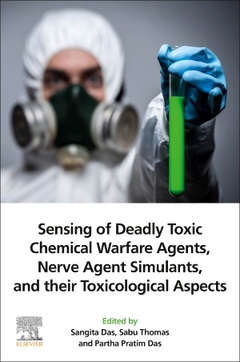Sensing of Deadly Toxic Chemical Warfare Agents, Nerve Agent Simulants, and their Toxicological Aspects
Coordonnateurs : Das Sangita, Thomas Sabu, Das Partha Pratim

Introduction
1. Chemical warfare agents: An outlook on past and present technologies 2. Metal-Organic-Framework Composite based rapid Self-Detoxifying Smart Textile Filters for Chemical-Warfare Agents 3. Plasmonic Nanosensors for Chemical Warfare Agents 4. Quantification of DCP (diethylchlorophosphate) for the recognition of organophosphorous chemical warfare agents 5. Advances in gold nanoparticles for optical detection of nerve agents 6. Functionalized two-dimensional photonic crystals for the detection of chemical warfare agents 7. Optically advanced Carbon dots for sensing of harmful toxins 8. Nano Materials in Organophosphate Sensing: Present and Future Perspective 9. Smart hydrogel nanostructured sensor for detection of organophosphorus chemical warfare nerve agents 10. Graphene based nanocomposites for detection of chemical messengers in nervous system 11. Aptamer based approaches for sensing harmful synthetic and natural toxins 12. MOFs derived nanoarchitectures for the detection of phenolic compounds 13. Sensing of Phenol and Chlorophenols using Carbon Nanotubes Modified Glassy Carbon Electrode 14. Nanotubes tethered laccase biosensor for sensing of chlorophenol substances 15. Use of organic compounds as Medical Products for the therapeutic treatment exposed to CW's agents 16. An assessment of Chemical Warfare Agents in soils: Detection, Distribution and Ecotoxicology 17. Assessment of the impact of chemical weapons disposal in the ocean according to international conventions 18. Chemical Warfare: Unprecedented Environmental Threat 19. Clinical Symptoms of Chemical Warfare Agents Toxicity including Mustards, Halogenated Oximes, Arsenicals, Toxins Poisoning 20. Advances targeted therapy in toxicology and medical treatment of chemical warfare nerve agents 21. The reversible inhibitors of acetylcholinestrerase as pre-treatment options against nerve agents intoxications 22. Paraoxonase 1 as a potential prophylactic countermeasure against nerve agent poisoning 23. Potential Alternative treatments and Routes of Administrations: Chemical Warfare Agents Poisoning 24. Therapeutic Treatment of Nerve Agent toxicity 25. Carbon-nanomaterial modified molecularly imprinted polymers for the sensing of Organophosphorus simulants 26. Carbon-nanomaterial modified recognition platforms for the sensing of organophosphorous simulants 27. Graphene-based nanocomposites for electrochemical sensing of Organophosphate triesters 28. Synthesis of simulants of nerve agents for the assays of AChE inhibition 29. Toxicological and Pharmacological Aspects of Organophosphorus Nerve Agents
Professor Sabu Thomas is the Director of Centre for Nanoscience and Nanotechnology, Mahatma Gandhi University, Kottayam, Kerala, India. He is also currently the Chairman of the Trivandrum Engineering Science and Technology Research Park (TrESPARK), Trivandrum, Kerala, India. He was the former Vice Chancellor of Mahatma Gandhi University, Kottayam, Kerala, India. Prof. Thomas is a highly committed teacher and a remarkably active researcher well-known nationally and internationally for his outstanding contributions in polymer science and nanotechnology. He has published over 140
- Provides an efficient, reliable, and highly versatile approach for the synthesis of different molecular systems suitable for diversity-oriented strategies, structure-activity studies and molecular tailoring for the sensing of chemical warfare agents
- Goes into depth on new binary organogels, discrete carbon nanomaterials (CNMs) and molecularly imprinted polymers (MIPs) and has endowed electrochemical chemosensors (ECCSs) with high selectivity and sensitivity towards the detection of chemical warfare agent
- Highlights in detail the detection of CWs by composite optical waveguide sensors, and describes disposable biofilm biosensors for sensitive detection of biotoxicity in water with treatment of nerve agent poisoning
Date de parution : 09-2022
Ouvrage de 764 p.
15.2x22.8 cm
Thème de Sensing of Deadly Toxic Chemical Warfare Agents, Nerve... :
Mots-clés :
?Acetamiprid; Acetylcholinesterase; Aflatoxin; Analytical chemistry; Analytical chemistry analysis; Analytical electrochemistry; Anticholinergics; Anticonvulsants; Aptamer; Aptasensors; Atropine; Bio-electrochemistry; Bioaccumulation; Biochemical analysis; Bioscavengers; Biosensor; Biotransformation; Blister agents; Blistering agent; Blood agents; Botulinum toxin; Breakdown products; Butrylcholinesterase; CWAs; Carbamates; Carbon dots; Carbon material; Carbon nanomaterial; Carbon nanotubes; Carbon-nanomaterial; Chemical Warfare Agent; Chemical agents; Chemical war; Chemical warfare; Chemical warfare agent; Chemical warfare agents; Chemical warfare agents (CWAs); Chemical weapons; Chemical weapons convention; Chemistry; Chlorophenol; Chlorophenols; Choking agents; Chromogenic–fluorogenic probes; Colorimetric; Conductive polymer; DNA; DNA alkylation; Debye ring; Dermal; Determination; Diethyl chlorophosphate; Drug; Drug development; Ecotoxicology; Electrochemical sensor; Electrochemical sensors; Electrochemistry; Energy storage; Environmental chemical engineering; Environmental impact; Environmental impacts; Environmental pollution; Experimental approach in biochemistry; Experimental toxicology; Fluorescent; Fresh frozen plasma; GPCR receptors; Gas chromatography; Glassy carbon electrode; Glutamate; Gold nanoparticles; Graphene; Graphene nanocomposites; Graphene oxides; Graphene quantum dots; Hemodialysis; High mechanical strength; Homeland security; Hydrogel; Hydrolysis; Inflammation; Inhalation; Inhalation injury; Interference; Laccase; Materials chemistry; Materials structure; Metal–organic framework; Metal–organic frameworks; Military activities; Modified electrodes; Molecular imprinted polymer; Molecularly imprinted polymers; Mustard gas; Mycotoxins; Nanocomposite; Nanofiber; Nanomaterial; Nanomaterial-enable sensor platform


